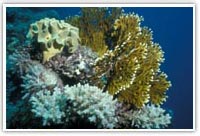
Coral Reefs in the RSGA Region
Overview: 
The coral reefs of the Region are composed of approximately 200 species of stony corals, representing the highest diversity in any section of the Indian Ocean. The warm water and absence of freshwater input provide very suitable conditions for coral reef formation adjacent to the coastline. In the northern Red Sea the coast is fringed by an almost continuous band of coral reef, which physically protects the nearby shoreline. This beautiful environment is extremely attractive as a tourist resource and is currently visited by hundreds of thousands of people each year, who dive, walk, and swim in the waters adjacent to the reefs.
Further south the coastal shelf becomes much broader and shallower and the fringing reefs gradually disappear to be replaced by shallow, sandy shorelines and mangroves. Coral reefs become more numerous offshore in this part of the Region.
Threats and Issues:
CORAL REEF FRAGILITY. Coral reefs also occur as offshore patch reefs and reefs fringing islands. They provide food and shelter for a large and diverse fauna and flora. Most fishing activities in the Region occur in shallow waters in the vicinity of coral reefs. Corals require a range of physical conditions for healthy growth and reproduction, all of which are influenced by human activities. Physical destruction, changes in water quality—such as raised nutrient levels, and changes in salinity and temperature—high levels of sedimentation, and changes in water currents can all damage coral reefs. Recovery, through new growth and larval settlement, requires a considerable amount of time and freedom from chronic stress.
DESTRUCTION OF CORAL REEFS. Coral reefs throughout the Region are being damaged by a variety of coastal developments, and as a direct result of human activities. Landfilling for urban expansion and tourism developments are destroying. Construction activities also alter the flow of clear seawater that corals need to survive. Corals are affected by the reduced light levels, and sometimes smothered by sediment from dredging. Release of semi–treated and untreated sewage directly onto coral reefs causes a proliferation of algae that can overgrow corals. Although coral reefs are attractive to tourists, unmanaged activities of divers and reef–walkers, and anchors from boats, destroy corals in high–use areas. Damaged areas become unattractive and the numbers of animals living there decline. Damage to coral reefs is further compounded by the limited use of environmental assessment for developments and low enforcement of the existing, adequate regulations. A lack of awareness about the importance of coral reefs and their sensitivity puts them further at risk.
CONTROL OF CORAL AND SHELL COLLECTION. In most of the Region, collection of corals and reef–associated invertebrates is illegal, but marine curios are still offered for sale throughout the Region. Existing regulations are in need of revision in a regional context. Control mechanisms and enforcement of regulations should be strengthened and accompanied by an extensive public awareness programme. Existing initiatives in Egypt, Jordan, Saudi Arabia, and Sudan may serve as a basis for the development of a comprehensive programme.
Monitoring Activities: Surveys and Reports
PERSGA has conducted routine surveys of coral reefs in the region, executed by PERSGA-trained regional specialists, in order to evaluate the present status of these key ecosystems and prepare the groundwork for conservation plans. Suveys have been conducted in Saudi Arabia, Egypt, Yemen, Djibouti, and Sudan in April through June 2002.
These surveys have provided a substantial body of data for national inventories and an important information foundation against which future data can be compared to detect and measure changes that might be occurring due to natural events or human interference. Furthermore, the collection of data has enabled PERSGA to furnish a report on the status of coral reefs in the region, as well as propose guidelines for conservation measures.
PERSGA compiles all data collected for its science, research and monitoring activities into a comprehensive GIS database.
For additional detailed reports, visit the Global Coral Reef Monitoring Network Website: www.gcrmn.org
Standardised Survey Methodology:
PERSGA has developed a regionally-applicable and scientifically robust Standardised Survey Methodology to facilitate its monitoring of key species and habitats in the region.
As of 2001, PERSGA has conducted a series of training courses as per below to teach specific survey methods relevant to each of its Habitat and Biodiversity priority components. The training courses were also used as tools to evaluate the methods and determine their applicability to the region.
- Training for Standardized Survey Methods – Reef Check Methods; Egypt, September 2000
- Training for Standardized Survey Methods for Coral Reefs; Jordan, June 2001
Conservation Action:
PERSGA has developed a Regional Action Plan (RAP)that provides a set of priority actions for the conservation and sustainable use of coral reefs in the Red Sea and Gulf of Aden. The Plan was developed in recognition of the great economic, ecological, and aesthetic importance that these ecosystems provide and in response to the serious threats posed by increasing human and natural impacts. Furthermore, the RAP defines a set of priority actions that are needs to ameliorate predicted impacts on the region’s reefs. It identifies expected results in regards to these actions and outlines performance indicators and methods of quality assurance.
In addition to the Regional Action Plan, PERSGA works with its individual Member States to furnish National Action Plans relating to Coral Reef conservation
Adopt a Coral Sapling - Incorporating artificial reefs in the gulf of Aqaba
A new initiative of PERSGA has been the creation of artificial reefs in Jordan as a pilot study for the possible extension of this measure across the region. To help facilitate its success, PERSGA in partnership with ASEZA has conducted extensive public awareness activities and invites the public to "Adopt a Coral Sapling".